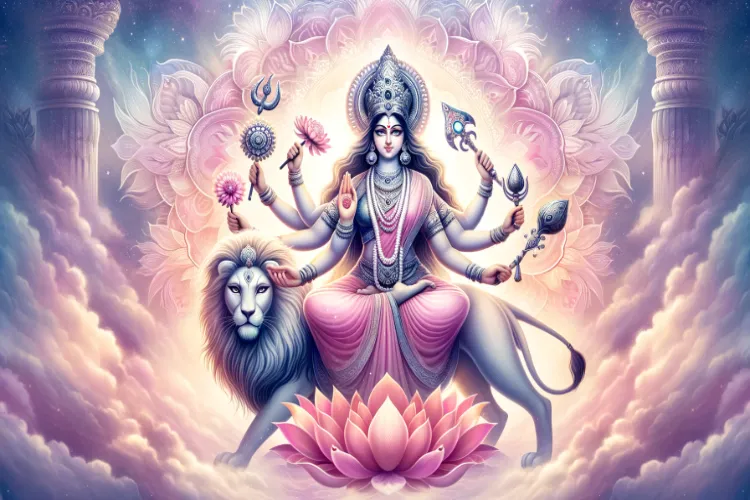
Vidushi Gaur/ New Delhi
Navratri, the nine-day festival dedicated to the worship of Goddess Durga in her various forms, culminates with Day 9, also known as Maha Navami. This day holds immense spiritual and cultural importance, as it is believed that the goddess manifested in her most powerful and benevolent form, Maa Siddhidatri.
The ninth form of Durga represents perfection and divine completeness, blessing her devotees with spiritual enlightenment, wisdom, and strength.
According to Hindu mythology, when the universe was being created, Lord Shiva worshipped Adi-Parashakti to gain spiritual powers. It is said that Siddhidatri blessed him with the perfection of all Siddhis (spiritual and mystical powers). She also granted him half her body, and thus he came to be known as Ardhanarishwara, a form that embodies both masculine and feminine energies.
The goddess in this form is depicted seated on a lotus, holding a mace, chakra, conch, and lotus in her four hands. Her serene expression and compassionate presence are believed to remove ignorance and fulfill all desires of her devotees. By worshipping Siddhidatri, devotees seek not just worldly success but also liberation (moksha).
Day 9 also recalls the culmination of Goddess Durga’s battle with the demon Mahishasura. For nine days and nights, she fought fiercely, embodying different aspects of power and protection. On the final day, she slayed Mahishasura, marking the victory of good over evil. This story is at the heart of Durga Puja celebrations in eastern India and symbolises that divine strength ultimately restores balance and righteousness in the world.
Rituals and Traditions
On Maha Navami, households and temples across India perform special prayers and rituals. Devotees rise early, take a holy bath, and prepare offerings for the goddess. Many observe fasts on this day, breaking it only after the evening puja.
A central tradition is the worship of Kanya Pujan or Kanjak, where nine young girls symbolising the nine forms of Durga are invited into homes. Their feet are washed, they are offered food, gifts, and new clothes, and they are revered as living embodiments of the goddess herself. This ritual reflects the deep respect for feminine power and purity in Indian culture.
In temples, elaborate havan (fire offerings) are conducted to invoke divine blessings. The chanting of mantras, devotional songs, and the rhythmic sound of dhol and conch shells fill the atmosphere with spiritual energy.
Celebrations Across India
Navratri’s final day is marked differently across the country, reflecting India’s cultural diversity:
In North India, particularly in states like Uttar Pradesh, Haryana, and Punjab, Ram Leela performances reach their climax on Navami. The enactment of Lord Rama’s victory over Ravana, followed by the burning of effigies on Dussehra, symbolises the triumph of dharma (righteousness).
In West Bengal, Maha Navami is part of the grand Durga Puja festivities. People gather in pandals (temporary shrines) adorned with exquisite idols of Durga, Lakshmi, Saraswati, Kartikeya, and Ganesha. Devotees offer elaborate bhog (prasad) and participate in the dhunuchi dance, where incense-filled earthen pots are balanced while dancing to drumbeats.
In Gujarat and Maharashtra, the night of Navami witnesses vibrant Garba and Dandiya Raas. People dressed in colourful traditional attire dance in circles, singing folk songs in praise of the goddess. The energetic celebration reflects unity, devotion, and joy.
In South India, the day is marked with Ayudha Puja, a unique tradition where people worship their tools, instruments, vehicles, and weapons. It is a symbolic reminder that all forms of work, whether intellectual, artistic, or physical, are blessed by divine energy.
In Eastern states like Odisha and Assam, the ninth day includes community feasting, cultural programs, and immersion preparations for the goddess’s idols.
The Spiritual Message
Beyond rituals and regional practices, Navratri Day 9 carries a profound spiritual message. The goddess Siddhidatri is seen as the epitome of completeness, teaching that human life is fulfilled not by material success alone, but by inner peace, wisdom, and devotion. Her blessings are sought to remove ignorance and guide devotees toward a path of balance and harmony.
The nine days of Navratri symbolise a spiritual journey from self-discipline (Day 1) to divine realisation (Day 9). By the time Maha Navami arrives, devotees are believed to have purified their minds and souls, ready to receive the grace of the goddess.
Navratri Day 9 is not just the conclusion of a festival; it is the celebration of victory, enlightenment, and divine grace. Whether through the dramatic rituals of Durga Puja in Bengal, the rhythmic dances of Gujarat, or the reverence of Ayudha Puja in the South, this day unites millions in devotion to Shakti, the eternal source of energy and power.
ALSO READ: PM Modi terms India's Asia Cup victory 'Operation Sindoor' on games field
As the goddess Siddhidatri showers her blessings, devotees are reminded of the eternal truth that with faith, courage, and wisdom, good always prevails over evil and light always dispels darkness.
